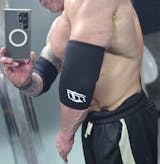The Only Lifting Belt Guide You’ll Ever Need
Whether you’re a competitive powerlifter, a CrossFitter, or someone just getting serious about weight training, a lifting belt can be one of the most valuable tools in your gym bag—if you know how to use it right.
In this guide, we’re cutting through the noise to help you understand:
- The different types of belts
- What size and thickness is best for your body and your lifts
- How to break in and care for your belt
- And most importantly, when (and when not) to wear one
Let’s get into it.
Types of Lifting Belts: What’s the Difference?
There are three main types of belts used in strength training. Choosing the right one comes down to your training style, preferences, and goals.
1.Lever Belts
- Best for: Powerlifters and heavy lifters who need maximum support
- Pros: Quick on/off, extremely tight and secure, consistent tension
- Cons: Less adjustable; needs tools to resize
- Our take: If you’re squatting or deadlifting in the 400–800+ lb range regularly, this is your go-to. They lock you in tight and don’t budge.
2.Prong Belts (Single or Double)
- Best for: All-around strength training and bodybuilding
- Pros: More adjustable, solid support
- Cons: Takes longer to put on/take off; double prong can be harder to thread
- Our take: Great for those who train a variety of lifts and want flexibility without sacrificing support.
3.Velcro Belts
- Best for: CrossFit, Olympic lifting, or circuit-style training
- Pros: Lightweight, easy to adjust on the fly
- Cons: Less supportive under max effort loads; wears out faster
- Our take: Perfect for fast-paced workouts and athletes who need mobility, but not recommended for heavy squats or pulls.
What Size and Thickness Should You Get?
Getting the right fit is just as important as picking the right type.
Width (4-inch vs. 6-inch):
- 4-inch belts are standard and legal in powerlifting meets.
- 6-inch belts are sometimes preferred by taller lifters or for added back coverage during general training, but they may dig into ribs/hips.
Thickness (10mm vs. 13mm):
- 10mm: Offers a great balance of support and comfort. Ideal for most lifters.
- 13mm: Maximum stiffness and support. Takes longer to break in and can feel bulky. Best for elite lifters handling very heavy weights.
Sizing Tips:
- Measure around your waist where you wear your belt, not your pants size. Usually right around the belly button.
- A snug, but not suffocating, fit is ideal. You want to brace into the belt, not rely on it to hold you up.
Pro Tip: If you’re between sizes, size down for lever belts, and size up for velcro belts (due to stretch over time).
How to Break In and Care for Your Belt
Breaking It In:
- Wear it often—every training session, even during warmups
- Do plenty of torso flexion and bracing drills with it on
- Some lifters roll it up tightly overnight to soften it faster
- Expect a 2–4 week break-in period for leather belts
Caring for Your Belt:
- Wipe it down with a damp cloth occasionally (especially if it gets sweaty)
- Avoid soaking or using harsh cleaners—just light leather conditioner every few months
- Hang it or store flat—don’t keep it crumpled in your gym bag
- Keep away from direct heat/sunlight to avoid drying out the leather
When (and When NOT) to Wear a Lifting Belt
A belt is a tool—not a crutch. It’s not meant to replace core strength, but to help you brace harder under heavy loads.
When to Wear It:
- Heavy squats, deadlifts, overhead presses
- Near-max effort sets (typically 80%+ of 1RM)
- Volume sets where fatigue makes bracing harder
- Strongman or powerlifting events
When to Skip It:
- Warm-ups and mobility drills
- Core isolation exercises (planks, hanging leg raises, etc.)
- Light accessory lifts (rows, curls, etc.)
- If you’re still learning to brace properly without one
Pro Tip: Learn to brace WITHOUT a belt first. Then, when you add the belt, your bracing will be even stronger.
Final Thoughts
A lifting belt won’t automatically make you stronger—but it will help you lift heavier, safer, and with more confidence when used properly.
At Team Industry, we design belts built to last, made from premium materials, tested by lifters who walk the walk. Whether you’re pulling 225 or 725, the right belt can be a game-changer.
Shop Our Best-Selling Belts → https://teamindustry.co.uk/collections/weight-lifting-belts
Have questions about sizing or finding the right belt? Drop a comment below or message our support team—we’ve got your back (literally).




